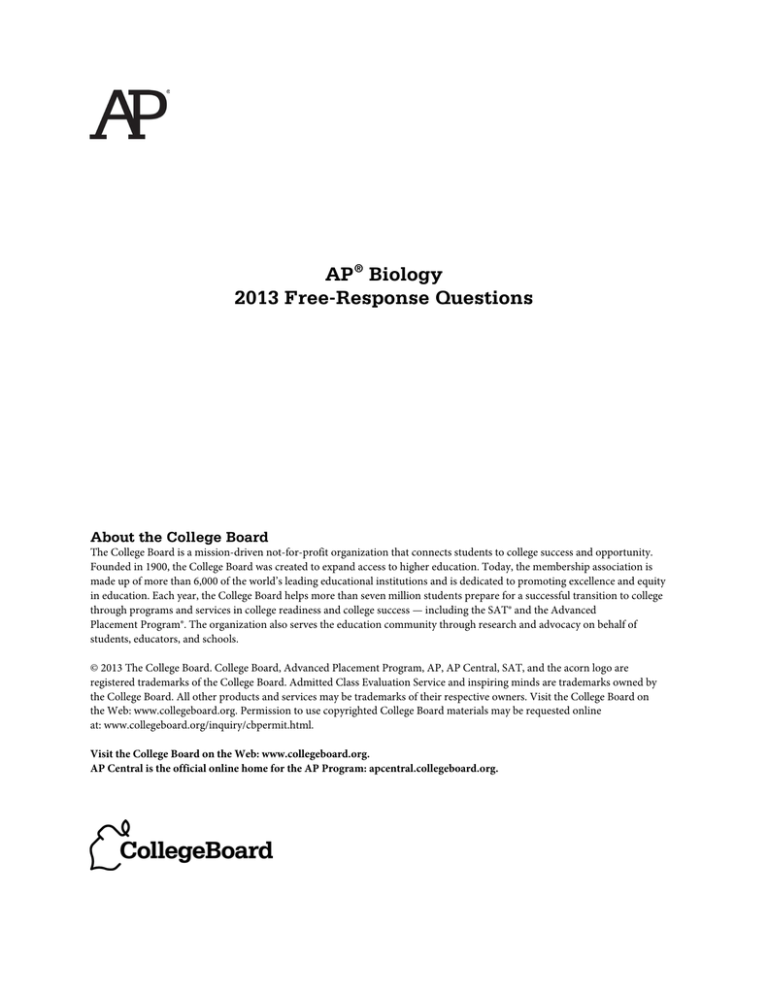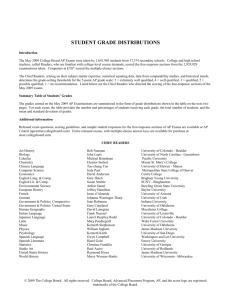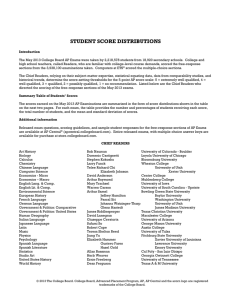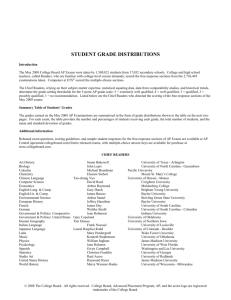AP Biology 2013 Free-Response Questions
advertisement

AP® Biology 2013 Free-Response Questions About the College Board The College Board is a mission-driven not-for-profit organization that connects students to college success and opportunity. Founded in 1900, the College Board was created to expand access to higher education. Today, the membership association is made up of more than 6,000 of the world’s leading educational institutions and is dedicated to promoting excellence and equity in education. Each year, the College Board helps more than seven million students prepare for a successful transition to college through programs and services in college readiness and college success — including the SAT® and the Advanced Placement Program®. The organization also serves the education community through research and advocacy on behalf of students, educators, and schools. © 2013 The College Board. College Board, Advanced Placement Program, AP, AP Central, SAT, and the acorn logo are registered trademarks of the College Board. Admitted Class Evaluation Service and inspiring minds are trademarks owned by the College Board. All other products and services may be trademarks of their respective owners. Visit the College Board on the Web: www.collegeboard.org. Permission to use copyrighted College Board materials may be requested online at: www.collegeboard.org/inquiry/cbpermit.html. Visit the College Board on the Web: www.collegeboard.org. AP Central is the official online home for the AP Program: apcentral.collegeboard.org. 2013 AP® BIOLOGY FREE-RESPONSE QUESTIONS BIOLOGY Section II 8 Free-Response Questions Time------90 minutes Directions: Questions 1 and 2 are long free-response questions that should require about 22 minutes each to answer and are worth 10 points each. Questions 3 through 8 are short free-response questions that should require about 6 minutes each to answer. Questions 3 through 5 are worth 4 points each, and questions 6 through 8 are worth 3 points each. Read each question carefully and completely. Write your response in the space provided following each question. Only material written in the space provided will be scored. Answers must be written out in paragraph form. Outline form is not acceptable. Labeled diagrams may be used to supplement discussion, but unless specifically called for by the question, a diagram alone will not receive credit. 1. In an investigation of fruit-fly behavior, a covered choice chamber is used to test whether the spatial distribution of flies is affected by the presence of a substance placed at one end of the chamber. To test the flies’ preference for glucose, 60 flies are introduced into the middle of the choice chamber at the insertion point indicated by the arrow in the figure above. A cotton ball soaked with a 10% glucose solution is placed at one end of the chamber, and a dry cotton ball with no solution is placed at the other end. The positions of flies are observed and recorded every minute for 10 minutes. (a) Predict the distribution of flies in the chamber after 10 minutes and justify your prediction. (b) Propose ONE specific improvement to each of the following parts of the experimental design and explain how the modification will affect the experiment. < Experimental control < Environmental factors (c) The experiment described above is repeated with ripe bananas at one end and unripe bananas at the other end. Once again the positions of the flies are observed and recorded every minute for 10 minutes. The positions of flies after 1 minute and after 10 minutes are shown in the table below. © 2013 The College Board. Visit the College Board on the Web: www.collegeboard.org. GO ON TO THE NEXT PAGE. -2- 2013 AP® BIOLOGY FREE-RESPONSE QUESTIONS DISTRIBUTION OF FLIES IN CHOICE CHAMBER Position in Chamber Time (minutes) End with Ripe Banana Middle End with Unripe Banana 1 21 18 21 10 45 3 12 Perform a chi-square test on the data for the 10-minute time point in the banana experiment. Specify the null hypothesis that you are testing and enter the values from your calculations in the table below. (d) Explain whether your hypothesis is supported by the chi-square test and justify your explanation. (e) Briefly propose a model that describes how environmental cues affect the behavior of the flies in the choice chamber. PART (C): CHI-SQUARE CALCULATION Null Hypothesis: Observed (o) (o e) /e 2 Expected (e) End with ripe banana Middle End with unripe banana Total © 2013 The College Board. Visit the College Board on the Web: www.collegeboard.org. GO ON TO THE NEXT PAGE. -3- 2013 AP® BIOLOGY FREE-RESPONSE QUESTIONS Color Wavelength (nm) Violet 380–450 Blue 450–475 Cyan 475–495 Green 495–570 Yellow 570–590 Orange 590–620 Red 620–750 2. An absorption spectrum indicates the relative amount of light absorbed across a range of wavelengths. The graphs above represent the absorption spectra of individual pigments isolated from two different organisms. One of the pigments is chlorophyll a, commonly found in green plants. The other pigment is bacteriorhodopsin, commonly found in purple photosynthetic bacteria. The table above shows the approximate ranges of wavelengths of different colors in the visible light spectrum. (a) Identify the pigment (chlorophyll a or bacteriorhodopsin) used to generate the absorption spectrum in each of the graphs above. Explain and justify your answer. (b) In an experiment, identical organisms containing the pigment from Graph II as the predominant lightcapturing pigment are separated into three groups. The organisms in each group are illuminated with light of a single wavelength (650 nm for the first group, 550 nm for the second group, and 430 nm for the third group). The three light sources are of equal intensity, and all organisms are illuminated for equal lengths of time. Predict the relative rate of photosynthesis in each of the three groups. Justify your predictions. (c) Bacteriorhodopsin has been found in aquatic organisms whose ancestors existed before the ancestors of plants evolved in the same environment. Propose a possible evolutionary history of plants that could have resulted in a predominant photosynthetic system that uses only some of the colors of the visible light spectrum. © 2013 The College Board. Visit the College Board on the Web: www.collegeboard.org. GO ON TO THE NEXT PAGE. -4- 2013 AP® BIOLOGY FREE-RESPONSE QUESTIONS 3. Fossils of lobe-finned fishes, which are ancestors of amphibians, are found in rocks that are at least 380 million years old. Fossils of the oldest amphibian-like vertebrate animals with true legs and lungs are found in rocks that are approximately 363 million years old. Three samples of rocks are available that might contain fossils of a transitional species between lobe-finned fishes and amphibians: one rock sample that is 350 million years old, one that is 370 million years old, and one that is 390 million years old. (a) Select the most appropriate sample of rocks in which to search for a transitional species between lobe-finned fishes and amphibians. Justify your selection. (b) Describe TWO pieces of evidence provided by fossils of a transitional species that would support a hypothesis that amphibians evolved from lobe-finned fishes. 4. Matter continuously cycles through an ecosystem. A simplified carbon cycle is depicted below. (a) Identify the key metabolic process for step I and the key metabolic process for step II, and briefly explain how each process promotes movement of carbon through the cycle. For each process, your explanation should focus on the role of energy in the movement of carbon. (b) Identify an organism that carries out both processes. © 2013 The College Board. Visit the College Board on the Web: www.collegeboard.org. GO ON TO THE NEXT PAGE. -5- 2013 AP® BIOLOGY FREE-RESPONSE QUESTIONS 5. The table below shows the amino acid sequence of the carboxyl-terminal segment of a conserved polypeptide from four different, but related, species. Each amino acid is represented by a three-letter abbreviation, and the amino acid residues in the polypeptide chains are numbered from the amino end to the carboxyl end. Empty cells indicate no amino acid is present. Relative Amino Acid Position Species 1 2 3 4 5 6 7 8 9 10 I Val His Leu Val Glu Glu His Val Glu His II Val His Leu Lys Glu Glu His Val Glu His III Val His Leu Val Glu Glu His Val IV Val His Leu Val Arg Trp Ala Cys Met Asp (a) Assuming that species I is the ancestral species of the group, explain the most likely genetic change that produced the polypeptide in species II and the most likely genetic change that produced the polypeptide in species III. (b) Predict the effects of the mutation on the structure and function of the resulting protein in species IV. Justify your prediction. 6. The following data were collected by observing subcellular structures of three different types of eukaryotic cells. RELATIVE AMOUNTS OF ORGANELLES IN THREE CELL TYPES Cell Type Smooth ER Rough ER Mitochondria Cilia Golgi Bodies X Small amount Small amount Large number Present Small amount Y Large amount Large amount Moderate number Absent Large amount Z Absent Absent Absent Absent Absent Based on an analysis of the data, identify a likely primary function of each cell type and explain how the data support the identification. © 2013 The College Board. Visit the College Board on the Web: www.collegeboard.org. GO ON TO THE NEXT PAGE. -6- 2013 AP® BIOLOGY FREE-RESPONSE QUESTIONS 7. In an experiment, rats averaging 300 g of body mass were tested several times over a three-month period. For each individual rat, urine was collected over a three-hour period after ingestion of 10 mL of liquid (water, 1% ethyl alcohol solution, or 5% ethyl alcohol solution). The volume of urine was then measured, and the results were averaged for all individuals within each experimental group. The data are shown in the table below. THREE-HOUR URINE OUTPUT FOLLOWING FLUID INGESTION Fluid ingested (10 mL) Average urine output (mL) Water 1% Ethyl Alcohol 5% Ethyl Alcohol 3.5 3.8 4.7 (a) Pose ONE scientific question that the researchers were most likely investigating with the experiment. (b) State a hypothesis that could be tested to address the question you posed in part (a). (c) Using the data in the table, describe the effect of ethyl alcohol on urine production. © 2013 The College Board. Visit the College Board on the Web: www.collegeboard.org. GO ON TO THE NEXT PAGE. -7- 2013 AP® BIOLOGY FREE-RESPONSE QUESTIONS 8. The figure above represents a generalized hormone-signaling pathway. Briefly explain the role of each numbered step in regulating target gene expression. STOP END OF EXAM © 2013 The College Board. Visit the College Board on the Web: www.collegeboard.org. -8-







